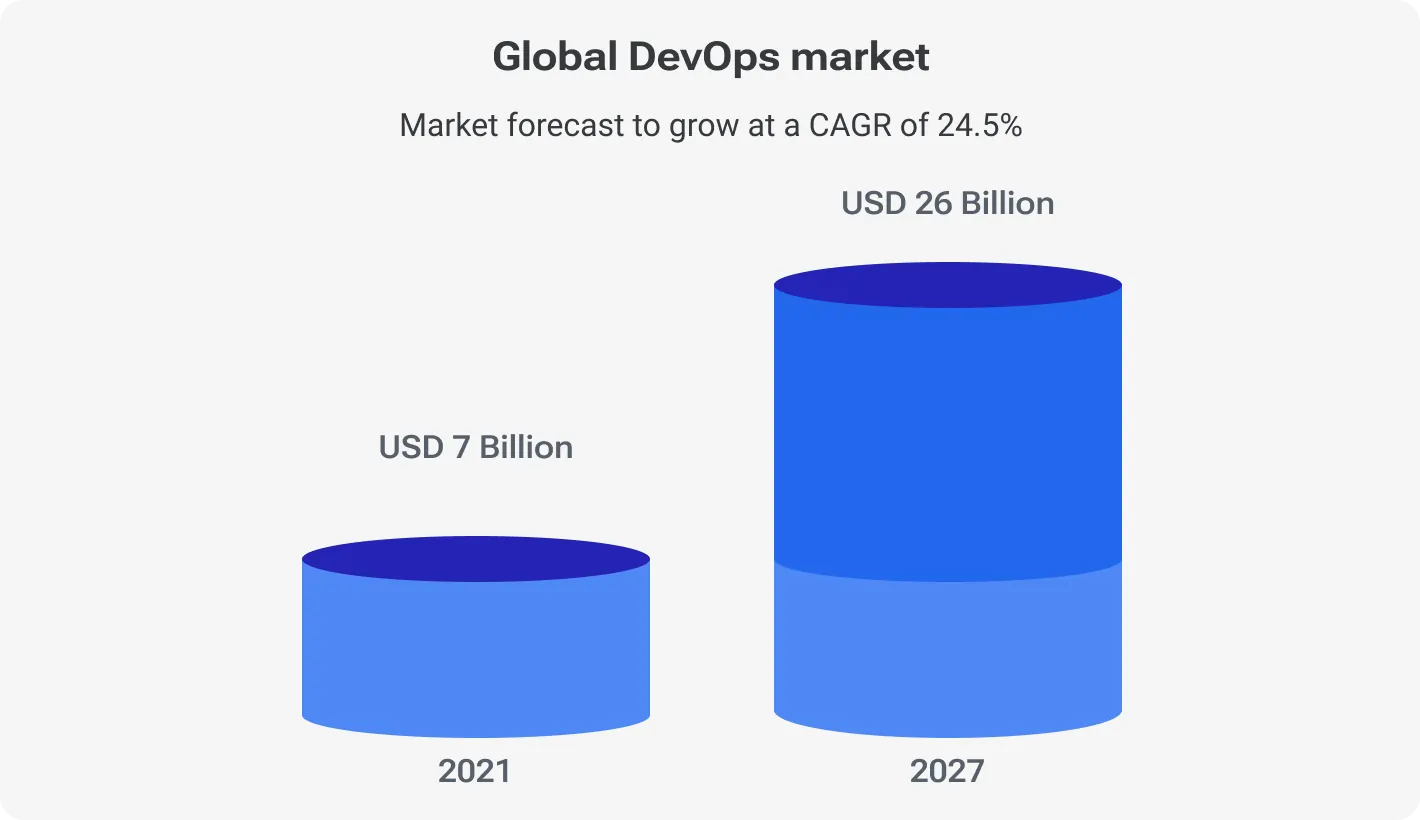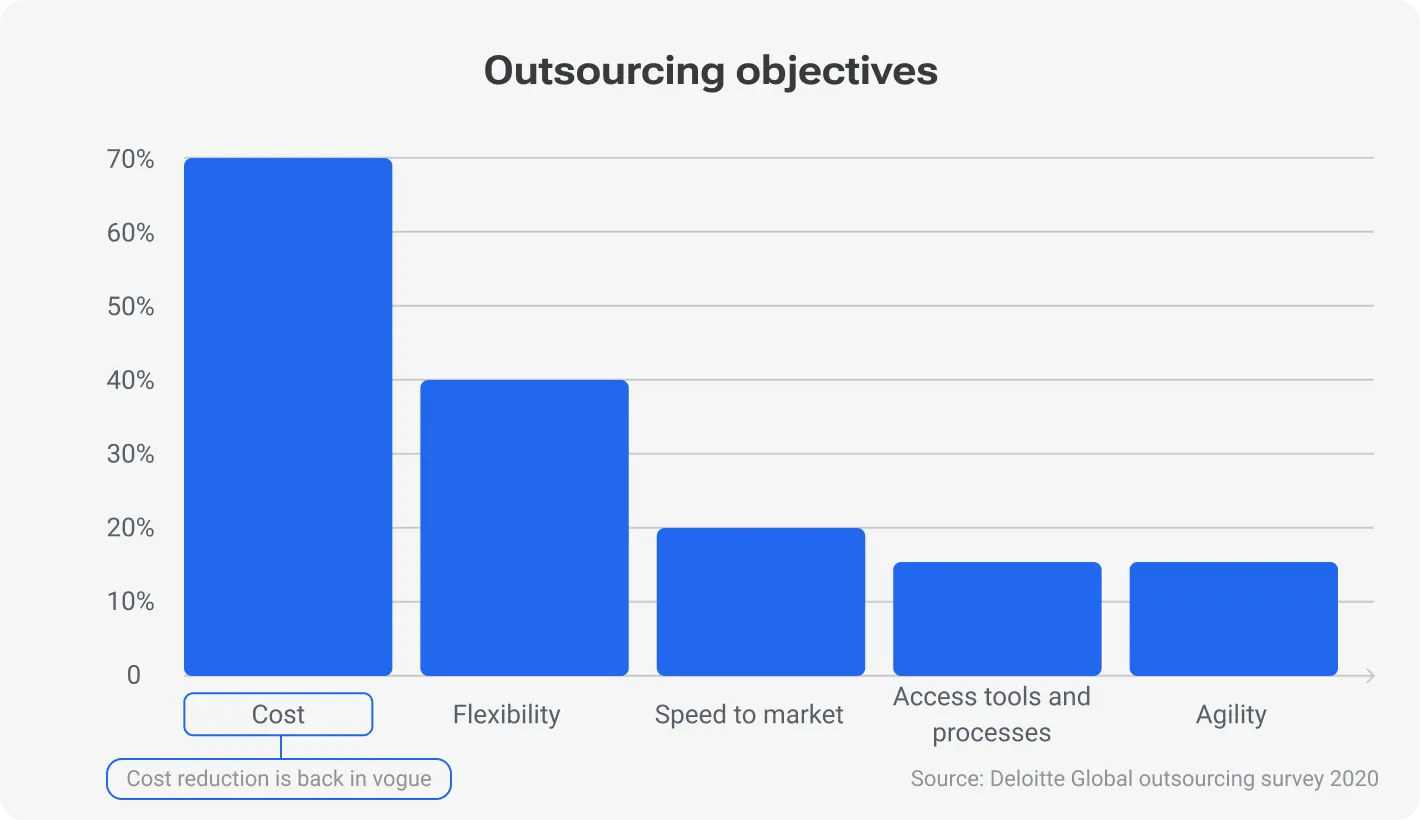Outsourcing to Czechia

How much does it cost to hire developers in Czechia?
Dec 2nd 25 - by Devico Team
Find out how much it costs to hire software developers in Czechia in 2025. Compare hourly rates, roles, and factors that impact pricing.
Hire
Hire by role
Hire Front-end developers
Hire Back-end developers
Hire Full-stack developers
Hire Android developers
Hire iOS developers
Hire Mobile developers
Hire AI engineers
Hire ML engineers
Hire Automation QA engineers
Hire Blockchain developers
Hire Data engineers
Hire Cloud engineers
Hire by skill
Hire JavaScript developers
Hire TypeScript developers
Hire Ruby on Rails developers
Hire React Native developers
Hire Flutter developers
Hire Golang developers
Hire React.js developers
Hire Python developers
Hire PHP developers
Hire .NET developers
Hire Java developers
Hire Laravel developers

DevOps
October 15, 2024 - by Devico Team
Summarize with:
According to a recent survey by Harvard Business Review Analytics, a majority of respondents emphasized the importance of DevOps in improving speed to market, productivity, innovation, customer relevance, and service quality. This highlights the value of implementing this approach in software development.

Discover how DevOps services impact your business workflow and explore the key reasons for choosing this collaborative approach to optimize your software development process.
In order to keep their operations dependable and efficient, businesses should always seek methods to accelerate their development processes. To achieve these objectives, DevOps is a revolutionary approach. Due to limits in resources, gaps in knowledge, and money, many organizations have difficulty adopting and managing outsourced DevOps processes in-house. In this case, a DevOps outsourcing strategy might be the key to success.
A growing number of companies are choosing to outsource their DevOps processes in order to take advantage of external expertise and resources. DevOps, which combines development and operations, aims to expedite product delivery without compromising quality, enhance collaboration, and streamline software development. By outsourcing DevOps, companies can access a broader talent pool and greater experience than they could internally.
The ever-evolving digital world makes DevOps a crucial tool for firms to remain competitive. Faster product delivery to consumers, increased productivity, new ideas, more customer relevance, and improved service are just a few of the numerous ways this benefits organizations.

According to predictions, the global DevOps market is set to reach $26 billion by 2027, demonstrating how crucial DevOps is to the success of enterprises.
Skills shortage
A unique set of skills is required for DevOps, which combines software development with IT operations. Locating experts with the necessary knowledge might be difficult. More than half of the businesses surveyed by the DevOps Institute reported difficulties in locating qualified candidates.
DevOps Outsourcing
High costs
The high costs of maintaining an in-house DevOps team stem from the time and effort needed to recruit, train, and retain top talent. Salary range for DevOps engineers in the US may be anywhere from $113,000 to $171,000 per year, as reported on Glassdoor.
Complexity of tools and processes
A lot of work and effort goes into managing and integrating various DevOps technologies and procedures. In order to keep up with the latest techniques, companies often need to spend a lot of money on tools and training.
Resistance to change
Teams used to more conventional approaches to development and operations may be resistant to the changes that are required to implement a DevOps culture.
Software development and IT operations can be made much more efficient by incorporating DevOps into your company's workflows. It is crucial to assess your company's present needs and capabilities before executing or outsourcing DevOps. Make use of this checklist to evaluate your present procedures, spot any holes, and set objectives for a fruitful DevOps rollout.
Understand your present technical foundation with a detailed description of the software and hardware configurations, network architecture, and DevOps tools in use:
Inventory of all currently installed software and hardware.
The current network design is being evaluated.
Finding out what DevOps platforms and technologies are available now.
Evaluate the knowledge and abilities of your team to identify areas for improvement:
Assessing the skill set of the current team.
Identifying gaps in DevOps knowledge and expertise.
Assessing training and development needs.
Examine the operational aspects of your development and deployment processes to identify inefficiencies and enhance performance:
The present development and deployment processes are being evaluated.
Finding out how long the present development, testing, and deployment cycles are.
Identifying bottlenecks and inefficiencies.
Understand the role of automation in CI/CD pipelines and evaluate the current state of your tooling and automation:
Take a look at how automated CI/CD pipelines are right now.
Evaluation of tool compatibility and integration.
Assessing tools for monitoring and logging.
Prioritize security and compliance to maintain legitimacy and trust:
Evaluates current security procedures and policies.
Make sure that all rules and regulations are followed.
Finding weak spots and places that might need some work.
Assess the adaptability and scalability of your infrastructure to handle growth and change:
Assessing how well the present system can scale.
Managing peak loads involves recognizing constraints.
Adaptability to new procedures and technology with ease.
5 red flags: When DevOps might not be a good fit
If you want your DevOps team to be as efficient and productive as possible, there are five steps to completing a gap analysis:
Determine your objectives. Before you start the gap analysis, make sure that you and your DevOps team are in agreement. What matters more to you: enhancing efficiency, promoting greater cooperation, or shortening deployment cycles? With a clear idea of what you want to achieve, it's much simpler to prioritize improvement areas and conduct analysis.
Evaluate your current situation. Take a look at your current DevOps practices, tools, and processes. Find out what works and what may need some work by analyzing the team's operations, communication, and collaboration. What this procedure is all about is finding any gaps or areas that may need some development.
Find places that might be improved and areas that are lacking. By contrasting your current circumstances with your hopes and dreams, you may get a sense of both your current position and your desired future path. These voids may be linked to tools, automation, communication, or something else totally depending on your DevOps processes. Write these gaps down; they will be the major focus of your approach for development.
Come up with a plan. Once the shortcomings and opportunities for development have been identified, it is necessary to design a plan. Break down each issue into smaller, more doable steps to resolve them. Assigning responsibilities and setting due dates helps keep everyone on the same page and gets things done.
Make any necessary modifications while keeping a close watch on everything. Be careful to monitor the progress of your improvement initiatives and make any required revisions. Noting key metrics and signals can help you determine the effectiveness of your improvements. This way, you know your DevOps team is continuously becoming better and that any new vulnerabilities will be simple to spot.
By adhering to these steps, you may help your DevOps team improve their processes, collaboration, and overall effectiveness.

Outlining clear objectives and standards for the outsourcing process is essential for a successful collaboration. Planning the project's scope, timeline, and quality standards with great care leads to increased productivity and enjoyment. With 70% of businesses looking to save costs via outsourcing and 40% hoping to focus on core company functions, it's crucial to have clear objectives in order to meet specific needs and improve operational efficiency. (Deloitte, 2020 Global Outsourcing Survey).
Choosing an outsourcing partner for software development is critical to your project's success. The right partner can save time and money while providing access to specialized knowledge, whereas the wrong choice can lead to costly delays and poor results. Here's what to consider when evaluating potential partners:
The technical experience of the potential partner should be considered. Assemble a team of people that understand the coding and the technologies that are going to be used in order to work on that project and benchmark against each other.
You should also:
Review case studies and detailed descriptions of past projects.
Ask for client testimonials and references.
Evaluate the variety and complexity of projects in their portfolio.
Verify the success and impact of their previous work.
It can be quite advantageous to continue only with a partner who has already experienced the same challenges, as they can offer good answers and solutions.
It is essential to look through the partner’s portfolio, it should contain the already implemented projects and the ones that are still in progress. According to the study that was conducted by Clutch, companies place a highly significant value on the portfolio of the partner they would choose, with 62% of the companies stating so. You may estimate their skills, as well as the quality of work done by them from this. It is very acceptable to ask for recommendations and evaluations from satisfied clients. Any past clients that may have worked with the partners may have some further information about the quality of the services they received.
Most software development outsource partnerships fail because of poor communication between the service provider and the client. Determine the partner’s capability of fast responses and clear communication. Ensure that they know the various specifications of the project and are willing to work before actual development starts. It is much easier when there is proper communication and updates so that you can be well aware of the issues at hand or even address them on time if need be.
It is evident that quality assurance is an essential practice when it comes to developing flawless software. Know how the partner conducts tests and how they guarantee quality. The process of quality assurance is the aspect of outsourcing that companies consider most difficult. Ensure that you are conversant with the program’s testing and guarantee procedures. If you want a perfect product with no defects, then go for a partner who uses a strict testing procedure.
With the growth of the business, the software development goals may also transform.
Check their capacity to scale resources up or down as needed.
Evaluate their flexibility in adapting to new technologies or methodologies.
Assess their ability to handle increased project scope or complexity.
Ensure they can provide long-term support and development.
The privacy of data needs to be considered when creating software for non-business consumers. Gain further understanding of how the partner stores and processes data and the laid down laws concerning data management.
Verify their compliance with relevant data protection regulations (e.g., GDPR, CCPA).
Assess their data encryption and security protocols.
Inquire about their data breach response plan.
Ensure they have strict access controls and confidentiality agreements in place.
It was noted that among the criteria for selecting an outsourcing partner, pricing is one of the most important factors; however, it cannot be the only one.
Request a detailed cost breakdown and pricing model.
Compare their pricing with industry standards and competitors.
Assess the value they offer relative to their cost.
Consider hidden costs, such as additional fees for support or updates.
These often disregarded factors that dictate the success or failure of an outsourced project are cultural compatibility and communication. Harvard Business Review study found that outsourcing worked best for organizations whose cultures were a good fit. See how well the partner fits in with the company's culture and how well they grasp its objectives. Make sure they can work together on the assignment by testing their communication and language abilities.
The success of a project in the long run depends on the quality of the DevOps support and maintenance provided even after development has ended. Find out how quickly problems are resolved and what procedures the company has in place for post-development support by getting in touch with them. The program will continue to work and be up-to-date if the partner is dedicated to providing reliable support.
Conduct thorough background checks using online reviews and ratings.
Contact former clients for honest feedback on their experience.
Review detailed case studies to understand their approach and results.
Compare their performance metrics, such as project completion times and ROI.
Consistency in methods and resources is essential for smooth integration and communication. Partnering with a company that shares your interest in DevOps increases the likelihood of meeting your project's requirements with efficient, tailored solutions. This alignment results in more uniform deliverables, shorter learning curves, and faster onboarding.
How to choose the right DevOps service provider?
Outsourcing DevOps without a strategy will not provide the desired results. Beginning with the fundamentals of effective communication and ending with critical performance indicators, this book has everything you need to launch a successful outsourcing partnership.
Describe the procedure and its outcome. The next stage is to specify the exact activities that will be outsourced, together with the desired outcomes and due dates for completion. Everyone working on the project has a good idea of what to expect and what is needed when the scope is well-defined.
Get people talking to one another and working together. Create trustworthy avenues of communication by making use of resources that promote collaboration. In order to keep ourselves informed and in sync as a team, we may employ project management software, instant messaging, and frequent video conferencing.
Standardize your critical performance metrics. Set up reasonable key performance indicators (KPIs) to see how the outsourced relationship is faring. Some examples of such factors are the frequency of deployments, recovery time, and rate of failure change. To objectively evaluate progress and achievement, there must be clear measures.
Create a comprehensive service-level agreement and contract. These papers lay out the project's goals, timeframe, payment conditions, confidentiality agreement language, and compliance regulations; everyone involved should be acquainted with them. In a service-level agreement (SLA), the expected response time and quality standards of a service provider are laid out.
Maintain consistent evaluations of progress and check-ins. You can monitor your progress, discuss any problems, and change your approach as needed if you attend sessions regularly. This could be a more efficient method of handling regular reviews and check-ins. You can maintain the project on schedule and make sure everyone is understanding by checking in at regular intervals.
It is vital to have a thorough contract and SLA in place when outsourcing. In the case of a disagreement or conflict, the parties' obligations under these contracts will be legally enforceable. They also help in conflict resolution since they spell out the standard of service and give pointers for comparing actual performance.
To effectively manage an outsourced DevOps team, one must:
Establish communications: Hold frequent meetings and make good use of available communication technologies to keep in close touch with your team.
Establishing objectives: Make sure that everyone in the team knows what you want out of the project and how you intend to get it done.
Project management: Tasks and progress may be easily monitored with the help of project management software.
Alignment of process and culture: Educate the group on company policy and facilitate their integration with other departments via team-building exercises.
Security and compliance: Protect sensitive information by enforcing stringent security measures and checking for regulatory and standard compliance frequently.
Controlling quality: Create processes for reviewing code and assess the team's quality metrics regularly.
Support collaboration: To motivate your team to work together, it is important to acknowledge their accomplishments and facilitate the exchange of feedback.
Plan for scalability: Be ready for changes in workload and alter procedures to suit new technologies by planning for scalability.
86% of organizations actively and passively promote DevOps practices. Startups frequently seek ways to expedite the release of their solutions to the market. In this regard, partnering with a DevOps outsourcing company proves to be the optimal decision. However, when it comes to outsourcing DevOps, both new and old businesses have the potential to make errors.
Conflict between objectives and anticipations
Taking care of differences between what the customer wants and what will be delivered.
Establish and record project objectives in a clear and succinct manner. It is also important to make sure that reviews are done often.
The company's objective is to complete the project quickly, but the DevOps team knows that rushing the process may lead to errors and downtime. To resolve this conflict, the company may need to adjust its objective to accommodate the DevOps team's needs, such as increasing the budget or allocating additional resources.
Failure to communicate
Streamlining communication to eliminate confusion and save time.
Establish reliable channels of communication and keep everyone informed at all times.
IBM increased communication and cut down on project delays by using a single communication platform to expedite outsourced DevOps tasks.
Operating disparities and cultural factors
Culture and technique differences in the workplace are a major source of conflict.
Arrange cultural orientation courses and stress the need of valuing other traditions.
SAP held integration sessions and intercultural seminars to help in-house and outsourced personnel work together more effectively.
Lack of knowledge and experience
The knowledge about the specifics of your project and its tech stack is lacking in the outsourcing partner.
Put a premium on encouraging talent development and guarantee a thorough assessment of prospective partners, which will have knowledge about your project's particular technology.
Google made sure that all of its contracted workers got full training on Google's technology stack and project management tools.
To evaluate the success of your DevOps outsourcing relationship, monitor specific key performance indicators (KPIs). These metrics should reflect both the efficiency of the process and the quality of the results. This guide outlines essential KPIs, short-term gains, and return on investment (ROI) for measuring success in DevOps outsourcing.
Key performance indicators
Deployment frequency: Measures the frequency of successful new releases.
Lead time for changes: The time it takes from committing code to production.
Change failure rate: The proportion of deployments that encounter issues.
Mean time to recovery (MTTR): The average time required to recover from a production breakdown.
Customer complaints comparison: Compares complaints from before and after outsourcing.
To gauge the efficacy of a DevOps outsourcing partnership, key performance measures including deployment frequency, change failure rates, and mean time to recovery must be monitored. Use these metrics to see how much of an impact outsourcing has on improving both efficiency and quality.
Any company may benefit from outsourcing DevOps, which brings in top-tier talent at a low cost from across the globe. Outsourcing DevOps to professionals with relevant industry knowledge and best practices can bring great business benefits.
DevOps outsourcing benefits are significant, as it:
enhances efficiency,
reduces costs,
speeds up market delivery.
Choosing a DevOps partner is crucial for success. To get the highest code quality at a fair price and fast software delivery, pick a reliable technology partner. Devico can assist you regarding that. Contact us today and let us help you navigate the complexities of DevOps and achieve you.
Outsourcing to Czechia

Dec 2nd 25 - by Devico Team
Find out how much it costs to hire software developers in Czechia in 2025. Compare hourly rates, roles, and factors that impact pricing.
Outsourcing to Czechia

Nov 25th 25 - by Devico Team
Compare Czechia and Poland for software outsourcing in 2025. Discover costs, talent, infrastructure, and which country fits your project best.
Outsourcing to Czechia

Nov 18th 25 - by Devico Team
A complete guide to outsourcing software projects to Czechia, learn about costs, talent, benefits, and how to build successful partnerships in 2025.